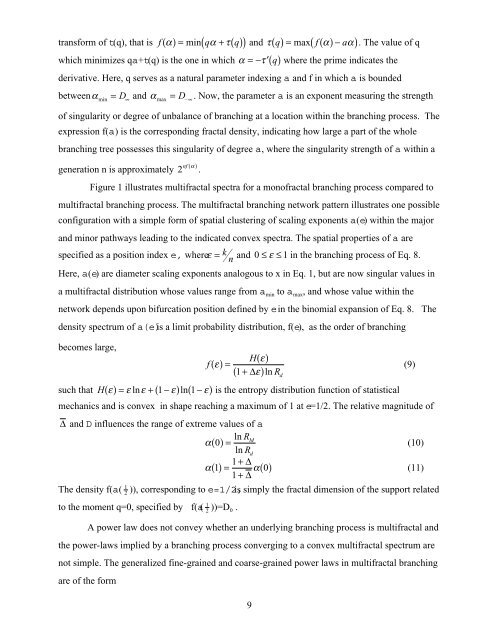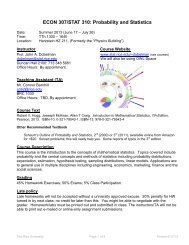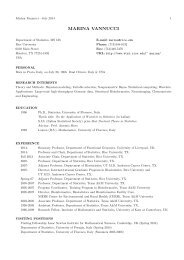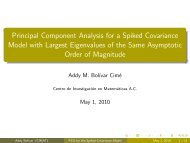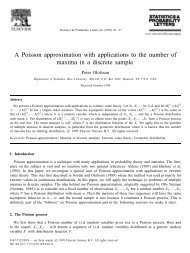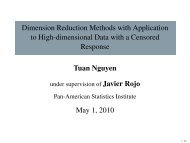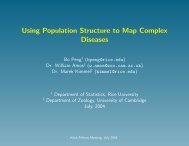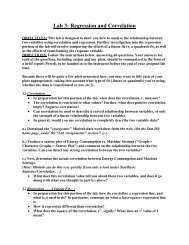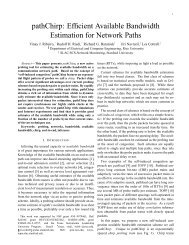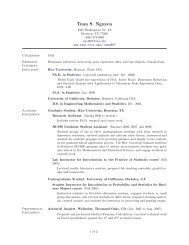Origin of Fractal Branching Complexity in the Lung - Department of ...
Origin of Fractal Branching Complexity in the Lung - Department of ...
Origin of Fractal Branching Complexity in the Lung - Department of ...
Create successful ePaper yourself
Turn your PDF publications into a flip-book with our unique Google optimized e-Paper software.
( )<br />
( )<br />
which m<strong>in</strong>imizes qa+t(q) is <strong>the</strong> one <strong>in</strong> which α =− τ′(<br />
q ) where <strong>the</strong> prime <strong>in</strong>dicates <strong>the</strong><br />
transform <strong>of</strong> t(q), that is f( α)= m<strong>in</strong> qα + τ(<br />
q)<br />
and τ( q)= max f( α)−aα . The value <strong>of</strong> q<br />
derivative. Here, q serves as a natural parameter <strong>in</strong>dex<strong>in</strong>g a and f <strong>in</strong> which a is bounded<br />
betweenα m<strong>in</strong> = D ∞ and α max = – ∞<br />
D . Now, <strong>the</strong> parameter a is an exponent measur<strong>in</strong>g <strong>the</strong> strength<br />
<strong>of</strong> s<strong>in</strong>gularity or degree <strong>of</strong> unbalance <strong>of</strong> branch<strong>in</strong>g at a location with<strong>in</strong> <strong>the</strong> branch<strong>in</strong>g process. The<br />
expression f(a) is <strong>the</strong> correspond<strong>in</strong>g fractal density, <strong>in</strong>dicat<strong>in</strong>g how large a part <strong>of</strong> <strong>the</strong> whole<br />
branch<strong>in</strong>g tree possesses this s<strong>in</strong>gularity <strong>of</strong> degree a, where <strong>the</strong> s<strong>in</strong>gularity strength <strong>of</strong> a with<strong>in</strong> a<br />
nf α<br />
generation n is approximately 2 ( ) .<br />
Figure 1 illustrates multifractal spectra for a mon<strong>of</strong>ractal branch<strong>in</strong>g process compared to<br />
multifractal branch<strong>in</strong>g process. The multifractal branch<strong>in</strong>g network pattern illustrates one possible<br />
configuration with a simple form <strong>of</strong> spatial cluster<strong>in</strong>g <strong>of</strong> scal<strong>in</strong>g exponents a(e) with<strong>in</strong> <strong>the</strong> major<br />
and m<strong>in</strong>or pathways lead<strong>in</strong>g to <strong>the</strong> <strong>in</strong>dicated convex spectra. The spatial properties <strong>of</strong> a are<br />
specified as a position <strong>in</strong>dex e, where ε = k n<br />
and 0≤ε ≤1<strong>in</strong><br />
<strong>the</strong> branch<strong>in</strong>g process <strong>of</strong> Eq. 8.<br />
Here, a(e) are diameter scal<strong>in</strong>g exponents analogous to x <strong>in</strong> Eq. 1, but are now s<strong>in</strong>gular values <strong>in</strong><br />
a multifractal distribution whose values range from a m<strong>in</strong> to a max, and whose value with<strong>in</strong> <strong>the</strong><br />
network depends upon bifurcation position def<strong>in</strong>ed by e <strong>in</strong> <strong>the</strong> b<strong>in</strong>omial expansion <strong>of</strong> Eq. 8. The<br />
density spectrum <strong>of</strong> a(e) is a limit probability distribution, f(e), as <strong>the</strong> order <strong>of</strong> branch<strong>in</strong>g<br />
becomes large,<br />
H(<br />
ε)<br />
f ( ε)=<br />
(9)<br />
( 1 + ∆ε) ln Rd such that H( ε)= εlnε + ( 1−ε) ln(<br />
1 − ε)<br />
is <strong>the</strong> entropy distribution function <strong>of</strong> statistical<br />
mechanics and is convex <strong>in</strong> shape reach<strong>in</strong>g a maximum <strong>of</strong> 1 at e=1/2. The relative magnitude <strong>of</strong><br />
∆ and D <strong>in</strong>fluences <strong>the</strong> range <strong>of</strong> extreme values <strong>of</strong> a<br />
α( 0)=<br />
ln RM<br />
(10)<br />
ln Rd<br />
1<br />
α()= 1 α 0<br />
1<br />
+ ∆<br />
( )<br />
(11)<br />
+ ∆<br />
The density f(a( 1<br />
2 )), correspond<strong>in</strong>g to e=1/2, is simply <strong>the</strong> fractal dimension <strong>of</strong> <strong>the</strong> support related<br />
to <strong>the</strong> moment q=0, specified by f(a( 1<br />
2 ))=D0 .<br />
A power law does not convey whe<strong>the</strong>r an underly<strong>in</strong>g branch<strong>in</strong>g process is multifractal and<br />
<strong>the</strong> power-laws implied by a branch<strong>in</strong>g process converg<strong>in</strong>g to a convex multifractal spectrum are<br />
not simple. The generalized f<strong>in</strong>e-gra<strong>in</strong>ed and coarse-gra<strong>in</strong>ed power laws <strong>in</strong> multifractal branch<strong>in</strong>g<br />
are <strong>of</strong> <strong>the</strong> form<br />
9


